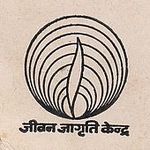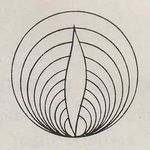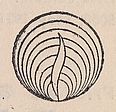Talk:Sannyas publishers and their symbols
A few things:
Jeevan Jagruti Kendra logo variations
More examples of JJK's logos have been found in some of Osho's early books, which expand the range of the "flames and circles" theme, found respectively in Who Am I (pub 1968), Meditation: A New Dimension (1970) and The Gateless Gate (1971):
It is not known if these three were early logo versions before a final one was settled on. And it may be worth noting that they weren't just publisher's marks. Who Am I was published by Motilal Banarsidass, a non-"house" publisher which was and still is deeply supportive of Osho. And the JJK logo is sporting a Devanagari text version of their name, even on an English book. The text portion at least seems to have been dropped early.

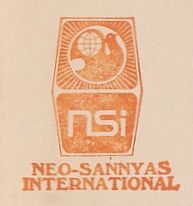
It can be seen in these three images that the number of circles was far from a fixed entity, with nine, ten, then back to nine. The inner flame also goes through some changes, piercing through the ninth circle in the middle image but retreating in the others, also varying in its waviness.
The latter two images are taken from the publisher's info page inside the books; there are other interesting logo-like forms found there too, which may get expanded on eventually. These are: in Dimension, a highly stylized "signature"-like representation of "Rajneesh" which also appears on the cover (image upper right) and in Gateless, a kind of stamp representing "Neo-Sannyas International" (lower right). Both these images can be seen in their context in the book pages. It will be seen that the NSI "logo" is a poor quality image, almost like a rubber stamp, in fact not unlike the rubber stamp of Paras, the San Francisco center of the day also found on the Gateless page. That, and the impression stamp of "Marvin's library" also on the page suggest that the NSI stamp may be more a copy ownership statement than anything. Stay tuned. -- doofus-9 16:44, 20 March 2016 (UTC)
Alternative Interpretations of the Pune One logo
An offering from Sw Anand Nirguna
The symbol is on any book of Poona 1 times.
The basic symbols are the point and the circle. The point symbolizes the center. It is the center within. And it is a symbol for the master who represents the center. If somebody has no connection to his center he may have a connection to the master. So the master becomes his center. With the help of the master he may get a connection to his own center.
The circle is a symbol for the periphery. The world is the periphery.
The Tao te King begins:
"The Tao that can be told is not the eternal Tao. The name that can be named is not the eternal name. The nameless is the beginning of heaven and Earth. The named is the mother of the ten thousand things."
"The ten thousand things" - that is the world. It is the periphery. From the center we watch the periphery. Or we do not watch and are somewhere lost in the ten thousand things. Then we are not one. Then we are many. Each identification creates a somebody.
There is no fundamental difference between the center and the periphery. They are two sides of one coin. The center contains the circle. And the circle contains the center. Basically they are one and the same. The center is the seed. The periphery is the flower. Everything develops from the center and is reflected in the periphery. And finally goes back to the center. Nothing exists without the center. Everything is connected with the center.
So another symbol for a circle is infinity. The symbol for infinity is ∞, two circles. The infinite is in the center. And the infinite is in the circle.
The three and the nine are between the center and the circle. They are symbols of a growing consciousness. There are infinite examples for the symbol of three. Not necessary, to run after them all. The root of them all is that three is a symbol of creation. If there is nothing and something starts growing out of nothing this growing is symbolized by the number three. This becomes clearer if one looks at the step in between, at the number of duality, two. But three is the process of creation. Three is a symbol of growth. It may be growth in a basic material sense. It also is growth in a spiritual sense.
The point symbolizes the master, the center. Three symbolizes the disciples around the master and their spiritual growth.
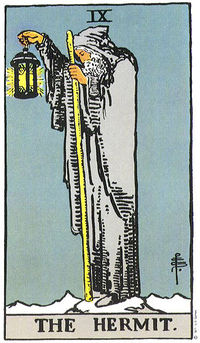
This leads us to nine.
In the Tarot you find "The Hermit" for number nine. The Hermit follows his own light. That is the whole work of the master: to lead the disciple to his own light so that he can follow his own light, his own wisdom. The work of the master is done. Then the circle, the infinite, is within the reach of the disciple. As is his center. Nine is a symbol of wisdom. Socrates says "I know that I know nothing". That is wisdom. He knew a lot. But he goes beyond that knowing into the realm of mystery. That is wisdom. That is seeing. That is light. Or like Osho calls it "philosia", which means the love of seeing, darshan. "Darshan" means "to see". In the number nine you find "darshan", seeing, wisdom, inner light.
The symbol of the time of Poona one that Osho choose is very beautiful and worth to remember. It has a very deep meaning.
Love Nirguna
A Hindi source for the Pune One logo?
It was written on the article page that Osho's concept for the Pune One logo, may have a source in a saying of Kabir. I could not verify this searching in Roman characters but came up with some possibilities in Devanagari. I searched for "एक से तीन, तीन से नौ" (ek se teen, teen se nau, from one to three, from three to nine), the core of the putative Kabir text. The English translations provided are from G**gle Translate and range from almost useless to sort of literal, but none very idiomatic. Results are copy-pasted without alteration.
First result is Osho's words from Suno Bhai Sadho, ch 11:
- संसार को जी लिया, देख लिया,स्रोत की और वापस पहुंच गए, स्रोत उपलब्ध हो गया, एक से तीन, तीन से नौ, नौ से पुनः एक।
- sansaar ko jee liya, dekh liya,srot kee aur vaapas pahunch gae, srot upalabdh ho gaya, ek se teen, teen se nau, nau se punah ek.
- G world had seen, and returned to the source, the source became available, one to three, three to nine, nine to a rewritten.
Second is also Osho's words, from Geeta-Darshan, Bhag 8, ch 1
- सारा संसार संख्या का विस्तार है, एक से तीन, तीन से नौ, नौ से इक्यासी, फिर इक्यासी गुणित इक्यासी, और आगे, और आगे। फिर ऐसे ही पीछे लौटना पड़ता है।
- saara sansaar sankhya ka vistaar hai, ek se teen, teen se nau, nau se ikyaasee, phir ikyaasee gunit ikyaasee, aur aage, aur aage. phir aise hee peechhe lautana padata hai.
- The whole world is the expansion of the number, one to three, three to nine, nine to eighty, eighty again Multiplied eighty-one, and so forth, and so forth. Then just have to turn back.
Throwing Kabir (कबीर) into the search terms got me those same two pages plus something from Nav Bharat Times, coincidentally the paper Osho worked at in Jabalpur. Unfortunately, something on that page wouldn't let me copy text. It did say one to three, three to nine, nine to 81 and then said something about "this formula", but i couldn't make it out. Other than that, it didn't look so promising, and Kabir was only mentioned quite a way before this passage. Here is the url if anyone wants to have a go at it.
And fwiw, a Krishna-oriented site which did not mention Kabir or Osho also went the whole way with this number-thing, just like Osho in Geeta Darshan and Nav Bharat Times:
- सांख्य शब्द की उत्पत्ति संख्या से हुई है। अर्थात एक और एक से तीन, तीन से नौ और नौ से 81 और 81 से अनंत।
- saankhya shabd kee utpatti sankhya se huee hai. arthaat ek aur ek se teen, teen se nau aur nau se 81 aur 81 se anant.
- Sankhya origin of the word is derived from the number. That is another one to three, three to nine and nine to 81 and from 81 to infinity.
The Star in the Rebel Logo

No great insights yet. Be the first!
Well, now that you ask ;-), I think the 6-pointed star in Osho's drawing must be Solomon's seal:
- In Judaism, particularly in Kabbalistic thinkings, that Solomon's seal is one of the most important symbols. That Solomon's seal is the symbol of the heart center. Sex moves downwards, so sex is like a triangle pointed downwards. Sahasrar moves upwards, So sahasrar is a triangle pointed upwards. And heart is just in the middle, where the sex triangle comes to meet the sahasrar triangle. Both triangles meet, merge into each other, and it becomes a six-pointed star, that is the seal of Solomon. The heart is the seal of Solomon.
- Once you have opened the heart, then you are available for the highest possibilities. Below the heart you remain man; beyond the heart you have become superman.
(Just joking. That is not me, but Osho in Yoga: The Alpha and the Omega, Vol 9 ch. 1) Sugit (talk) 13:38, 16 March 2016 (UTC)
About the Swan logo
It could be said that Prartho's swan painting featured in No Mind could have been based on Osho's original design, leaving no conflict with the account from osho.info. That would be one way to go but it does not fit with anecdotal evidence heard around that time, which had it that Osho did not design the logo himself but asked the commune's artists to submit designs, with Prartho's design becoming the winning one. One of the commune's well-known artists (whose design had not been chosen) referred to it as "that goose". Such a comment would not have been even contemplated if Osho had made the original design, it seems to me. Thus, the claim by osho.info that it is Osho's design may not be the case, and may be only there to further OIF's trademark claims.
It would also be good to know where the swan logo was actually used. So far all that is known is the short-term usage on Osho Times, possibly less than a year, and a few videos of the White Swan Brotherhood meetings possibly never commercially available. Anywhere else? Likely there is nothing being produced currently or even within the last twenty years with the swan logo on it, so one might wonder why the trademark is an active one. Perhaps to maintain as wide a variety as possible of tools to control other sannyasins' use of Osho-branded material? -- doofus-9 01:01, 27 February 2016 (UTC)
See also an interview with Prartho: LoveOsho podcast E081 Prartho.
